Adrian Collins's Blog, page 88
July 28, 2023
REVIEW: A Study in Drowning by Ava Reid
A Study in Drowning is, in their own words, Ava Reid’s first foray into true romance – and YA. It is their third novel after The Wolf and the Woodsman and Juniper and Thorn (read our review here). Like their two first books, A Study in Drowning is heavily influenced by folklore, stories and an investigation into the role women are given and can claim for themselves in a patriarchal society. There is off-the-page sexual abuse and a nuanced discussion of the trauma survivors face, especially when the person involved is in a position of power – so be aware of that going in if that is something you have difficulty with.
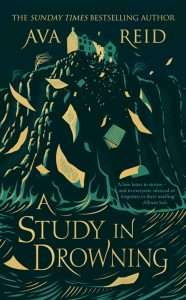 The story is centred around Effy, an architecture student struggling to make it through her university courses after rumours of sleeping with a professor spread. Instead, she flees into the worlds of her favourite poet, Emrys Myrddin, especially the poem Angharad. When she has the opportunity to enter a contest to re-design his estate, Hiraeth Manor, she jumps at the chance – and to everyone’s (and most of all, her own) surprise, Effy wins. At the remote estate the boundaries between what is real and what isn’t blur as she is pulled between the Faerie King, Myrddin’s brash son Ianto and the young scholar Preston – who is determined to unmask Myrddin as a fraud. And perhaps, just perhaps, Effy can find justice not just for herself and her own story, but another woman wronged by a man too…
The story is centred around Effy, an architecture student struggling to make it through her university courses after rumours of sleeping with a professor spread. Instead, she flees into the worlds of her favourite poet, Emrys Myrddin, especially the poem Angharad. When she has the opportunity to enter a contest to re-design his estate, Hiraeth Manor, she jumps at the chance – and to everyone’s (and most of all, her own) surprise, Effy wins. At the remote estate the boundaries between what is real and what isn’t blur as she is pulled between the Faerie King, Myrddin’s brash son Ianto and the young scholar Preston – who is determined to unmask Myrddin as a fraud. And perhaps, just perhaps, Effy can find justice not just for herself and her own story, but another woman wronged by a man too…
I loved how atmospheric and evocative A Study in Drowning is. The weather, Hiraeth Manor, the poetry all come to life so strongly through the writing and I could almost taste the rough sea air. It worked really well to draw out the disconnect between what was real and what wasn’t, the blurring of those boundaries of reality. I appreciated how, in this instance, it wasn’t something rooted in mental issues, but something deeper, something both uncanny and misogynistic. It made the relationships between the characters all the more frustrating to witness – in some ways like a train wreck you cannot look away from. As information comes to light and secrets unravel, the reader learns parts of the story and is able to piece details together that aren’t necessarily satisfying in themselves, but lead to a very satisfying conclusion.
Effy and Preston had a lovely rivals-to-lovers relationship, growing organically from instinctual dislike to curiosity to… something more. It was central to the story without overpowering their character arcs or the plot as a whole. I also really appreciated how each of the major characters was deeply flawed and inherently self-centred, motivated by their own selfish desires more than anything else. The greater good makes little difference in A Study in Drowning. In that sense, it is well suited for a grimdark audience, even if its core audience is perhaps younger and more female than those who tend to read our content. This is an interesting study in morality and how to make the greater needs of the truth play out in your personal favour. A book that has its weaknesses – it does lose tension in parts and perhaps drags a bit in the middle – but truly sticks the landing and had me scream in glee at its conclusion.
Read A Study in Drowning by Ava ReidThe post REVIEW: A Study in Drowning by Ava Reid appeared first on Grimdark Magazine.
July 27, 2023
REVIEW: Secret Invasion- Episode Three ‘Betrayed’
“BETRAYED” is the third episode of the SECRET INVASION series by Disney+. The premise of Secret Invasion is the Skrulls from Captain Marvel have elected a new leader in Gravik. Gravik is a former child soldier of the Skrull resistance who worked under Nick Fury before deciding that he’d been betrayed. Now Gravik believes the best solution to their lack of a homeworld is to kill everyone on Earth but for Skrulls. This is a plan that is missing a few steps.
Indeed, a large part of Secret Invasion‘s problems as a series stem from the fact that the series is not nearly complex enough to justify its spy thriller nature. The Skrulls are almost comically evil with their decision to kill all of humanity being poorly motivated, poorly thought out, and far over the top for their needs. A million Skrulls could fit into one city after all. There’s also the fact that the show keeps on resembling David Icke’s Anti-Semitic conspiracy theories regarding alien lizard men.
There’s also the not ridiculous idea that David Icke plagiarized Skrulls when he created his reptilian shapeshifters since so much of his hate-filled bile is from the collective unconsciousness of science fiction, conspiracy theories, and so on. After all, the theories that he created for this nonsense were in the Nineties and the Skrulls were created by Jack Kirby and Stan Lee in 1962.
The centerpiece of this episode, for me at least, is that Nick Fury confronts his Skrull wife about her possible involvement with Gravik. Mrs. Fury confronts Nick with the fact that he was dead for the Blip (five years) but also that upon his return from the dead, pretty much retreated to himself. It’s a harsh and interesting depiction of a relationship that has a lot of similarity to couples waiting for their loved ones to come back from war.
Another good moment is that we do get some more information on how Nick Fury ascended to become the head of SHIELD. Twenty Skrull agents were leant from the refugees to gather information for him. I like the number they chose because it is large enough that you can believe Nick got a lot of benefit from them but not so much that it makes no sense that they didn’t detect Hydra or other threats we know secretly existed.
Most of the episode is an attempt to prevent Gravik from starting World War 3 by having his agent provocateurs launch an unprovoked attack on the UN. This is one of those situations where you note that there are plenty of defenses in place to avoid “orders so crazy that they wouldn’t fit in Doctor Strangelove.” Fury and Talos successfully prevent the attack but only with the help of G’iah. This, of course, exposes her as a double agent.
Honestly, I’m not sure if I like or dislike the fact that Gravik is such a whiny poseur. His arguments are basic, he doesn’t appear to be nearly as intelligent as he seems, and his supposed genius comes off like all the adults in the room are manipulating him. I don’t know if this is deliberate or not, but I don’t think that he’s remotely as effective a villain as the show is presenting him as. In simple terms, he talks a big game, but I don’t buy him as the Big Bad.
The post REVIEW: Secret Invasion- Episode Three ‘Betrayed’ appeared first on Grimdark Magazine.
July 26, 2023
Exclusive: Cover Reveal for A Twist of Faith by Thiago Abdalla
We have a special treat today for our loyal grimdark readers: an exclusive cover reveal for A Twist of Faith by Thiago Abdalla, the third book of his Ashes of Avarin series.
The Ashes of Avarin kicked off with Abdalla’s highly rated debut novel, A Touch of Light, which earned a finalist slot in Mark Lawrence’s 8th Self-Published Fantasy Blog-Off (SPFBO8). Our review of A Touch of Light can be found here.
The series continued with A Shade of Madness, which introduced a new point-of-view character along with plenty of dark, griffin-laden action. Our review of A Shade of Madness is published here.
The cover art for A Twist of Faith was designed by Alejandro Colucci, the same artist who designed the covers of A Touch of Light and A Shade of Madness. Alejandro Colucci is an award-winning artist who has produced artwork for hundreds of fantasy, science fiction, crime, horror, and historical fiction publications, including illustrations for bestselling authors Anne Rice, Robin Hobb, Ursula K. Le Guin, Steven Erikson, and Joe Abercrombie.
A Twist of Faith will be released in Fall 2023.
ABOUT THE BOOKThe third book in the Ashes of Avarin series follows Adrian and Lynn as they fight off the invasion of the Domain and the Madness brought with it. The stakes are higher than ever as the enemy strikes a blow that goes deeper than flesh. It strikes at the core of the Faith itself. As the decay that started in the clanlands spreads to the Domain, Lynn and Adrian will take paths that will test their beliefs. Nasha is finding herself in the clanlands. She strives for unity among the clans and the power to fight the dead goddess, Zala, as she spreads her touch across the Silent Earth. Kadmus learns all he can, and searches for a way to bring back a cure to his daughter in the Domain.
COVER REVEAL
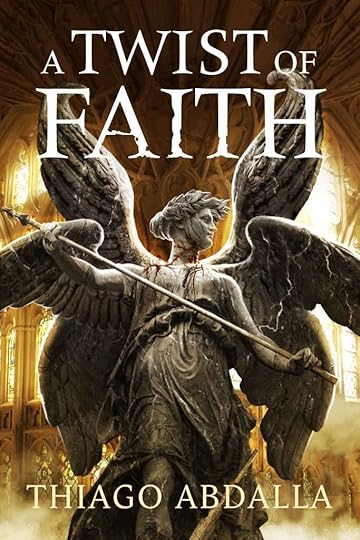
While the pre-orders aren’t up for A Twist of Fate just yet, if you join up to the authors mailing list (click here) you’ll get the latest updates on this release and a free novella.
The post Exclusive: Cover Reveal for A Twist of Faith by Thiago Abdalla appeared first on Grimdark Magazine.
July 25, 2023
REVIEW: Final Fantasy XVI
One of the oldest jokes in video game RPGs is how long-running the Final Fantasy franchise is, given its name. The original Final Fantasy, released in 1987 in Japan and 1990 in North America, was named partially because had it failed, Square might well have gone bankrupt. It was also by far my favorite game on the original Nintendo, and I’ve kept up with most of the games in the series as it’s progressed.
There’s been much talk in the fandom as to how different or similar this particular game is compared to others. Each game in the series has different gameplay and strategy, but this one is fully an action gameplay, with control of a single character (and his dog, and for a very brief sequence, one other character.)
Creative Business Unit III, a team within Square Enix, built this game, using inspiration from the popular Final Fantasy XIV MMORPG and the good seasons of Game of Thrones. It’s not necessarily that it’s a significantly bleaker world than some of the other games (6 and 7 in particular have some very bleak themes) but the greater the detail the more some of that bleakness can be made explicit.
You play as Clive Rosfield, and you start in a very Heroes Journey kind of story, a noble who’s also a Bearer—which means he can do magic without a crystal. He’s training to be a Shield, a knight protector, for his younger brother Joshua, who is a dominant of the Phoenix. Dominants mean that they have magic and can transform into Eikons, this Final Fantasy’s take on summoned monsters that have been a mainstay of the series since Final Fantasy III.
Things go awry, and Clive faces another Eikon who murders his brother and destroys much of Clive’s home while he is helpless to stop it. He is enslaved and dreams of nothing so much as gaining vengeance on the dominant who slew Joshua.
Clive however has a strange power in that he unwillingly takes powers of dominants and can then use them, which works as the sole playable protagonist in this sort of game. You can level up various powers and as the game progresses switch between various Eikon’s powers.
The other draw of this game are the major Eikon against Eikon battles, which are a lot of fun. It feels like Kaiju against Kaiju, without making the rest of the game feel meaningless. It’s an impressive line to walk.
The gameplay is generally quite easy. I have heard of people just making their way through it grinding the basic attack and the occasional magic spell, and while there are scenarios where this won’t work, they don’t come often. But it is more fun, and significantly faster, to chain attacks, and it’s not hard to do. The game has a new game+ which increases the difficulty and, from my understanding, requires a lot more strategy, but I have not played it.
The story is strong, balancing the typical Final Fantasy tropes (crystals, dragoons, moogles, chocobos) while going in a much more traditional story structure. The side quests don’t offer much in the way of experience or crafting supplies, but the stories in them ranges from passable to really, really good. In particular, the All Bark and Playthings sidequests in the Moore area are some of the most brutal stories I’ve seen in a Square Enix game. They’re also quite short. The hunt board, with powerful monsters you can optionally take down, are more fun from a gameplay standpoint even if the stories around them are nearly non-existent.
The crafting and gear mechanics are a legitimate problem, as there is never any real thought behind them. You are given near-limitless amounts of certain crafting supplies and then need one of something else that will only be unlocked by a hunt or a main boss. Your gear will be identical to the gear of anyone else playing the game.
In addition, while some of the eikonic powers are more useful than others, there isn’t any of the strategizing which monsters are vulnerable to which that was a mainstay of most of the prior games. Fire doesn’t do extra damage against cold enemies, nor lightning against water. Nor do they have status effects (the Malboro, feared in most Final Fantasies, is one of the first bosses in this because it can’t poison, blind, or stun you.)
That said, the gameplay is still fun, and the story remains engaging throughout. The game has some missteps and it does not feel like the older Final Fantasy games, but those games have evolved constantly through the years from the original through the job systems of 3 and 5, the flexibility of 6 and 7, the ‘whatever the junction system was’ of 8, the gambit system of 12, or the paradigm system of 13. Final Fantasy will keep changing between each game, and we can only hope the stories are worth it. For 16, it definitely is.
On a final note: If you really want the old school turn-based combat, might I recommend Octopath Traveler I or II? They’re also made by Square Enix and designed specifically to be like their classic era of JRPGs, and I really enjoyed both of them.
The post REVIEW: Final Fantasy XVI appeared first on Grimdark Magazine.
July 24, 2023
REVIEW: Secret Invasion- Episode Two ‘Promises’
Secret Invasion didn’t make a huge impression on me the previous episode. It felt like the show suffered from trying to rush into its premise without properly setting up its stakes or world-building. The Skrulls are going to kill us all! Yes, why? How? How did we get from the point of the Skrulls being the hated refugees hunted by the Kree Empire to the point that they’re planning to exterminate the race that has decided to host them.
“Promises” improves on this a bit by starting us off with flashbacks to Captain Marvel that probably should have been there from the very beginning. It also elaborates a bit on Skrull culture and numbers, letting us know that Nick Fury has been using them as spies for the past thirty years as well as the fact that they are numbering a million strong.
A million Skrulls works well for establishing the threat as it’s not so high it’s unbelievable that they could hiding among us Earthmen (and women) but not so low that they couldn’t be living in, say, Pripyat without disturbing anyone. Unfortunately, the episode also plays into some more unfortunate storytelling points that undermine the entire experience.
The episode itself follows Nick Fury in the aftermath of Maria Hill’s assassination at the hands of Gravik. Unfortunately, fans hoping that it would prove to be a fake-out are proven wrong. Not only do we see her body post-mortem, but we attend her funeral. Maria Hill’s mother even confronts Nick Fury in one of the stronger moments of the episode. Sadly, even that undermines Maria Hill as Nick Fury says it’s all about him. It was a trap to kill and frame him despite Maria Hill being one of the highest-ranking SHIELD operatives herself.
Much of the episode is about how Nick Fury has lost control over the situation and isn’t the spymaster he used to be. Honestly, that isn’t as strong a premise as it seems. Nick Fury’s biggest roles in the MCU have been almost getting steamrolled by the World Security Council during the Chitahuri invasion and missing Hydra had managed to subvert SHIELD from the very start of its existence. Which is to say he’s always been a supremely capable human being but not an infallible god either.
I’m also not sure why the Skrulls specifically blame Nick Fury. Carol Danvers promised to find them a new homeworld and Nick Fury backed her up, but it seems like they’d be more upset with Carol. Again, the episode makes Nick Fury into something of an untouchable god but I’m not sure why the Skrulls thought an Earth spymaster could provide them their own homeworld. Which plays into a larger issue of the episode, that the Skrulls are unreasonable jerkasses.
The Skrulls turn out to not be a bunch of impoverished refugees after all with the Skrull Council including the head of NATO, the Prime Minister of the UK, the General Secretary of the UN, and a Fox News pundit all being members. In other words, the Skrulls should be sitting pretty. It also unfortunately falls into a bunch of Anti-Semitic anti-UN global conspiracy tropes for seemingly no reason whatsoever. Again, I’m not sure what the Skrulls want here if they’re secretly in charge of the world.
The show is presently carried by Samuel L. Jackson’s charisma with moments like his story about living in segregation-era America and his conversation with James Rhodes being highlights of the episode. We also find out a shocking twist about his home life. I’m hoping this show will turn itself around but, right now, it’s not my favorite of Disney+’s MCU series.
The post REVIEW: Secret Invasion- Episode Two ‘Promises’ appeared first on Grimdark Magazine.
July 23, 2023
REVIEW: The Hunters by David Wragg
The Hunters by David Wragg is a fast-paced, runaway wagon ride of a book combining long, action-packed set pieces with a dynamic cast of quirky, highly memorable characters.
 For years Ree has lain low on her farm, evading her violent past to keep her niece Javani safe. When hired killers arrive in town searching for a white-haired woman and her child, Ree and Javani must race across the desert as multiple factions vie for their heads. Little do their pursuers know, it isn’t wise to hunt a hunter…
For years Ree has lain low on her farm, evading her violent past to keep her niece Javani safe. When hired killers arrive in town searching for a white-haired woman and her child, Ree and Javani must race across the desert as multiple factions vie for their heads. Little do their pursuers know, it isn’t wise to hunt a hunter…
The first book in the Tales of the Plains trilogy, The Hunters is set in the same world as David Wragg’s Articles of Faith series (which comprises The Black Hawks and The Righteous). Although there are plenty of callbacks for veteran fans (as confirmed by the man himself in our interview together), The Hunters is completely accessible for newcomers and can be read entirely on its own. Being one of those newcomers, and I was never confused or lost—only gripped to the edge of my seat.
Like any Grimdark writer worth their salt, David Wragg’s prose has a delightful, tongue-in-cheek frankness to it that can just as easily elicit a laugh from the reader as it can make them wince and cringe. So many lines had me cackling, from use of the word “cameltastrophe” in a sentence, to delightfully vivid imagery such as:
“I’ll drive this bolt through your skull and piss in the brain-hole.”
And:
“Anashe nodded, her mouth pulled together like a cat’s backside.”
The characters, as previously mentioned, are all very distinctive and rollicking good fun. My personal favourite was the White Spear—a ruthless mercenary of very few words who has a definitive air of the T-1000 about her when it comes to completing her contracts. Another highlight is the Acting Guildmaster Kurush, whose fragile ego and overreaching ambition make for an erratic, paranoid and thoroughly entertaining internal monologue littered with dramatic irony. In fact, all the side characters are a bit of a triumph; something that is important when dealing with a large ensemble cast. Every character’s point of view was interesting, and I didn’t switch off once.
If I have one criticism of The Hunters, it’s that I didn’t find myself overly attached to any of the main characters—specifically Ree, Javani, and the bickering siblings, Anashe and Aki. This meant that when stakes were high or things went bad, I found myself largely unmoved by some of the plot’s nastier developments. The focus of The Hunters is very much on the action, and while there are glimmers of deeper underlying emotion and heartfelt explorations of family ties, these are probably the weakest parts of the book. I also found the beginning a teensy bit on the slow side, but that feeling vanished the moment Javani’s eyes met those of the White Spear across the packed town square.
And oh, what brilliant action! Once I was done with The Hunters, I realised in a slightly breathless fashion that the bones of story take place over a mere 24 hours. In fact, the entire back half is just one long chase sequence with more twists and turns than you can shake a stick at. Stampedes, runaway wagons and explosives galore, the action in this book simply does not let up and is among the best I’ve ever read in fantasy. Comparisons to Joe Abercrombie’s Red Country and Mad Max: Fury Road are entirely warranted in this regard. Boy howdy! (Sorry).
Overall, The Hunters is a thoroughly enjoyable romp across a fantasy Wild West that I absolutely loved, even though it didn’t quite plumb the depths of my emotions as much as I would’ve liked. I highly recommend this one for Grimdark Magazine readers and am very much looking forward to getting my hands Book 2.
Read The Hunters by David WraggThe post REVIEW: The Hunters by David Wragg appeared first on Grimdark Magazine.
July 22, 2023
REVIEW: Deadhouse Gates by Steven Erikson
My Malazan Book of the Fallen re-read continues with Deadhouse Gates. I was looking forward to revisiting this novel, remembering that it contained great characters, memorable journeys, and soul-wrenching heartache.
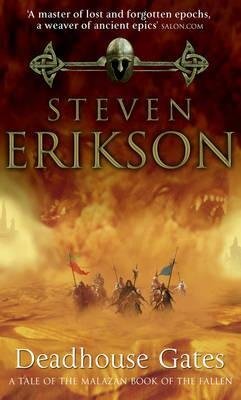 After getting to know the characters that were featured throughout Gardens of the Moon, Erikson introduces a mostly new ensemble in Deadhouse Gates. The events of this book take place throughout the Seven Cities, including the Holy Desert Raraku. This continent is currently occupied by the Malazan Empire however, driven by the prophetess Sha’ik and the Whirlwind, a rebellion is gaining traction.
After getting to know the characters that were featured throughout Gardens of the Moon, Erikson introduces a mostly new ensemble in Deadhouse Gates. The events of this book take place throughout the Seven Cities, including the Holy Desert Raraku. This continent is currently occupied by the Malazan Empire however, driven by the prophetess Sha’ik and the Whirlwind, a rebellion is gaining traction.
Throughout this tale, we follow half a dozen varied characters and groups, focusing on their journeys, agendas, or sorrow. One such band features some returning players from the previous entry, Bridgeburners Fiddler (sapper), Kalam (assassin), Apsalar (assassin), and Darujhistan resident Crokus. Elsewhere, we have the wanderings of two friends, Icarium and Mappo, both formidable warriors, one of whom is dangerously overpowered and has obliterated entire cities. Another main focus is that of Felisin Paran who has been betrayed by her elder sister following the Malazan Empire’s culling of certain noble houses. The most notable perspective in Deadhouse Gates and one that is hugely influential to the entire series is the Imperial Historian Duiker’s account of the Malazan’s 7th army during the uprising. The 7th is commanded by Fist, Wickan Crow Clan leader, war-veteran, and former enemy of the Malazan Empire, Coltaine. The narratives in Deadhouse Gates feel more focused and palatable to what was presented previously in Gardens of the Moon, with each group having duties and motives that we follow, some of which are more obvious than others.
‘No-one who’s grown up amidst scrolls and books can write of the world,’ Kellanved had told him once, ‘which is why I’m appointing you Imperial Historian, soldier.’
‘Emperor, I cannot read or write.’
‘An unsullied mind. Good. Toc the Elder will be teaching you over the next six months – he’s another soldier with a brain. Six months, mind. No more than that.’
‘Emperor, it seems to me that he would be better suited than I—’
‘I’ve something else in store for him. Do as I say or I’ll have you spiked on the city wall.’
Although I enjoyed following every perspective, there is a lot of travelling and wandering and this led to some segments dragging, therefore, being not that fun to read. With the 7th army, some of the action from the skirmishes blurred and seemed repetitive. This may have all been intentional by the author with the chaos and confusion presented not being crystal clear or easy to follow, it highlights the desperation and ups the stakes as this storyline approaches its devastating conclusion. This all being said, there are frequent moments of camaraderie and wit, in addition to heightened set-piece spectacles. One scene that stands out is a moment where Coltaine wishes to reward a soldier for bravery, yet, without intending to, demotes his rank, leading to awkward and comic results. These subtle moments of humanity, confusion, and events not always going a set way, however well-intentioned, add to the dramatic impact of this storyline.
If how grimdark a book is was solely rated by the levels of violence and tragedy then Deadhouse Gates would feature highly on such a scale. Lots of awful things happen, such as the unpleasant and dark horrors presented to Felisin throughout her fall from grace and the resulting journey. I will also note that I clearly remembered a character death that features in Deadhouse Gates from my first read 8 years ago. It shocked me then and was no less impactful on a second visit. What made this moment stand out is that it was an absolutely unpredictable and underserved death for a likeable, important cast member. This defied my expectations and changed the way I followed and cared for characters in later entries because everyone is expendable and even if a character is a fan-favourite, they will probably not get the spectacular death that their deeds warrant.
Who in the Abyss has such power? He could think of but two: Anomander Rake, the Son of Darkness, and Osric. Both Soletaken, both supremely arrogant. If there were others, the tales of their activities would have reached him, he was certain. Warriors talk about heroes. Mages talk about Ascendants. He would have heard.
We are presented with more insight into the magic scheme of warrens, mages, ascendants and gods in Deadhouse Gates. I adored the sense of dread, uncertainty, and powerlessness that players faced when finding themselves lost in a warren or fighting against extremely capable magic users. Following on from some of his exchanges in this book, I am already remembering why the ascendant Cotillion went on to become one of my favourite characters in the series
With the conflicts and revolution showcased in this novel, living in this world is difficult enough, and that is before you add into the mix shapeshifters, demons, undead dragons, deadhouses, and a spider-despising priest whose sanity is questionable. These high stakes and immense risks are probably one of the main reasons that I enjoy following and rooting for characters like Fiddler. He is not an overpowered mage or god-possessed assassin, he is a witty and honourable veteran soldier in an extremely dangerous environment.
I had a great time returning to Seven Cities and having the Malazan Empire expanded again to me as a reader. The world showcased here feels gritty, deadly, and dark, making some of the locations and set pieces in Gardens of the Moon seem almost cartoony by comparison. The novel’s finale is epic and intense, a tear-jerker that has stayed with me ever since I read it the first time. It does not get any easier to bear the second time. To conclude, quite simply, I consider Deadhouse Gates to be an incredible and impactful epic fantasy read. 9/10.
Read Deadhouse Gates by Steven EriksonLull nodded. ‘That’s a succinct summary of humankind, I’d say. Who needs tomes and volumes of history? Children are dying. The injustices of the world hide in those three words. Quote me, Duiker, and your work’s done.’
The post REVIEW: Deadhouse Gates by Steven Erikson appeared first on Grimdark Magazine.
July 21, 2023
Top ten new horror novels for grimdark fans
Grimdark fans love the darker side of fantasy and science fiction, which often intersects with the horror genre. In this listicle, we recommend ten recently published horror novels with strong elements of dark fantasy or science fiction that will appeal to grimdark fans. These books are noted for probing the darkest depths of the human psyche in worlds infused with magic or twisted technological advances.
We also shared our love of horror in issue #35 of Grimdark Magazine (July 2023), which features a horror-filled selection of short stories and book reviews.
Without further ado, here are ten outstanding new horror novels for fans of grimdark fantasy and science fiction.
Full Immersion by Gemma Amor Full Immersion, Gemma Amor’s deeply personal sci-fi horror, opens with a cry for help from the protagonist, Magpie, who pleads to be accepted into a new Virtual Experimental Therapy program to overcome her postpartum depression. Magpie has tried all traditional forms of therapy but still finds herself sinking further into despair. Her letter to the Virtual Experimental Therapy program concludes with three devastating words: “Please help me.”
Full Immersion, Gemma Amor’s deeply personal sci-fi horror, opens with a cry for help from the protagonist, Magpie, who pleads to be accepted into a new Virtual Experimental Therapy program to overcome her postpartum depression. Magpie has tried all traditional forms of therapy but still finds herself sinking further into despair. Her letter to the Virtual Experimental Therapy program concludes with three devastating words: “Please help me.”
Full Immersion is, first and foremost, a profound psychological analysis of a person who finds her way back from the deepest depths of postpartum depression. The sci-fi aspects of the story are a great vehicle for bringing Magpie’s mental state vividly to life. The horror elements mostly focus on Silhouette, a shadowy creature who represents the physical manifestation of Magpie’s depression, aggressively consuming everything in its path.
The finest books will leave such an indelible impact on the reader that it makes them a changed—and hopefully better—person. Full Immersion is one of those books.
Read the full review here.
ABOUT THE BOOKA traumatized woman with amnesia finds her own dead body and sets out to uncover the truth of her demise in a race against time, sanity, crumbling realities and the ever-present threat of the Silhouette.
When Magpie discovers her own dead body one misty morning in Bristol, it prompts her to uncover the truth of her untimely demise. Her investigations take her on a terrifying journey through multiple realities, experimental treatments, technological innovations and half-memories in a race against time and sanity. Accompanied by a new friend who is both familiar and strange, and constantly on the run from the terrifying, relentless presence of the mysterious predator known only as Silhouette, Magpie must piece together the parts of her life previously hidden. In doing so, she will discover the truth about her past, her potential, and her future.
Read the bookThe Salt Grows Heavy by Cassandra Khaw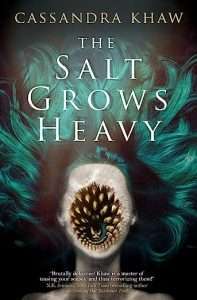 Cassandra Khaw’s latest book, The Salt Grows Heavy, is a darkly beautiful nightmare brought to life, which will drive a dagger through your heart and leave you begging for more.
Cassandra Khaw’s latest book, The Salt Grows Heavy, is a darkly beautiful nightmare brought to life, which will drive a dagger through your heart and leave you begging for more.
The Salt Grows Heavy feels like a hallucinatory night terror from Hans Christian Andersen. Khaw cranks the darkness knob all the way to the “black hole” setting, sucking the reader into the story and refusing to let go.
The Salt Grows Heavy is a truly mesmerizing story and one of the finest works of horror and dark fantasy I’ve ever read, dripping with a gruesome and disquieting passion.
Read the full review here.
ABOUT THE BOOKFrom USA Today bestselling author Cassandra Khaw comes The Salt Grows Heavy, a razor-sharp and bewitching fairytale of discovering the darkness in the world, and the darkness within oneself.
You may think you know how the fairytale goes: a mermaid comes to shore and weds the prince. But what the fables forget is that mermaids have teeth. And now, her daughters have devoured the kingdom and burned it to ashes.
On the run, the mermaid is joined by a mysterious plague doctor with a darkness of their own. Deep in the eerie, snow-crusted forest, the pair stumble upon a village of ageless children who thirst for blood, and the three “saints” who control them.
The mermaid and her doctor must embrace the cruelest parts of their true nature if they hope to survive.
Read the bookA Dance for the Dead by Nuzo Onoh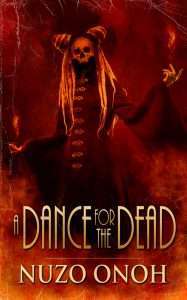 Nuzo Onoh lives up to her title of “Queen of African Horror” with her latest novel, A Dance for the Dead. Stitched with powerful imageries of dark magics and secret rites, Onoh weaves a macabre tale of revenge.
Nuzo Onoh lives up to her title of “Queen of African Horror” with her latest novel, A Dance for the Dead. Stitched with powerful imageries of dark magics and secret rites, Onoh weaves a macabre tale of revenge.
A Dance for the Dead takes place in the Kingdom of Ukari and the ten villages, a world of cruelty and raw beauty. Onoh’s latest novel is a celebration of nightmarish imagination. It is African horror triumphant.
Read the full review here.
ABOUT THE BOOKOn a moon-lit night, Diké, heir to the Kingdom and leader of the terrifying warrior cult, the Ogwumii, falls asleep inside his bedroom. He wakes up to find himself trapped within the secret shrine of the village deity, a dark cave forbidden to all save the powerful witchdoctors.
Overnight, the mighty warrior-prince becomes an Osu—an untouchable and outcast.
In disgraced exile in the forbidden shrine, his sole companion is the raging ghost of a murdered slave girl, wrongly sacrificed to the gods on the false prophecy of a lecherous witchdoctor. To break the Osu curse, Diké must find the traitors who orchestrated his downfall and embark on a terrifying journey to the ancestors’ realm, a deadly quest that could end his life or return him to full citizenship and glory.
Read the bookThe God of Endings by Jacqueline Holland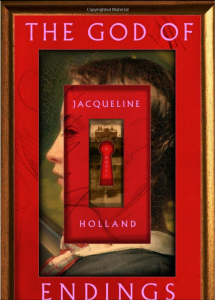 The God of Endings is the masterful debut novel by Jacqueline Holland, a literary dark fantasy that explores the purpose of life through the eyes of a reluctant immortal.
The God of Endings is the masterful debut novel by Jacqueline Holland, a literary dark fantasy that explores the purpose of life through the eyes of a reluctant immortal.
The basic premise of The God of Endings, i.e., following the lonesome life of a protagonist who defies human mortality, parallels the classic 1820 Gothic fantasy, Melmoth the Wanderer, by Irish novelist Charles Maturin, focusing on weighty themes such as the search for meaning and permanence in a life where everything is transient.
Altogether, The God of Endings is a hauntingly beautiful dark fantasy that serves as a meditation on the arrogance and love associated with bringing new life into the world.
Read the full review here.
ABOUT THE BOOKBy turns suspenseful and enchanting, this breathtaking first novel weaves a story of love, family, history, and myth as seen through the eyes of one immortal woman.
Collette LeSange is a lonely artist who heads an elite fine arts school for children in upstate New York. Her youthful beauty masks the dark truth of her life: she has endured centuries of turmoil and heartache in the wake of her grandfather’s long-ago decision to make her immortal like himself. Now in 1984, Collette finds her life upended by the arrival of a gifted child from a troubled home, the return of a stalking presence from her past, and her own mysteriously growing hunger.
Combining brilliant prose with breathtaking suspense, The God of Endings serves as a larger exploration of the human condition in all its complexity, asking us the most fundamental question: is life in this world a gift or a curse?
Read the bookLeech by Hiron Ennes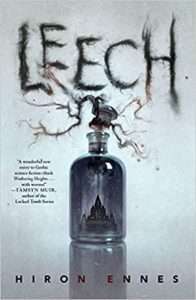 In Verdira, a brutal winter encroaches as a replacement arrives for a recently deceased doctor. Both the dead doctor and the replacement are part of The Institute, where doctors are trained; but they also both share the same hive-mind. The fact that the replacement has no idea how the original doctor died is cause for concern—what could have happened that the hive mind isn’t aware of?
In Verdira, a brutal winter encroaches as a replacement arrives for a recently deceased doctor. Both the dead doctor and the replacement are part of The Institute, where doctors are trained; but they also both share the same hive-mind. The fact that the replacement has no idea how the original doctor died is cause for concern—what could have happened that the hive mind isn’t aware of?
As Leech continues, the paranoia ramps up as nearly every character displays something that could suggest infection, coming to a head in one of the creepiest, most unnerving scenes involving a bloody mix of body horror and vile character dynamics. As the climax hits, paranoia falls away for something both stranger and stronger. It’s a great ending to this fantastic, weird, unsettling novel.
Read the full review here.
ABOUT THE BOOKIn an isolated chateau, as far north as north goes, the baron’s doctor has died. The doctor’s replacement has a mystery to solve: discovering how the Institute lost track of one of its many bodies.
For hundreds of years the Interprovincial Medical Institute has grown by taking root in young minds and shaping them into doctors, replacing every human practitioner of medicine. The Institute is here to help humanity, to cure and to cut, to cradle and protect the species from the apocalyptic horrors their ancestors unleashed.
In the frozen north, the Institute’s body will discover a competitor for its rung at the top of the evolutionary ladder. A parasite is spreading through the baron’s castle, already a dark pit of secrets, lies, violence, and fear. The two will make war on the battlefield of the body. Whichever wins, humanity will lose again.
Read the bookA Song for the Void by Andrew C. Piazza A Song for the Void is Andrew C. Piazza’s masterful cosmic horror set in the South China Sea during the Opium Wars between Great Britain and China in the mid-nineteenth century. This historical setting is the perfect backdrop for Piazza’s exploration of nihilistic philosophies and psychological manipulation.
A Song for the Void is Andrew C. Piazza’s masterful cosmic horror set in the South China Sea during the Opium Wars between Great Britain and China in the mid-nineteenth century. This historical setting is the perfect backdrop for Piazza’s exploration of nihilistic philosophies and psychological manipulation.
Horror comes in the form of an evil-looking eye in the sky, which the sailors view as a strange stationary comet. The eye is known as the Darkstar and is the physical manifestation of nihilism, manipulating the minds of the crew members to convince them that their lives are meaningless. The power of the Darkstar is especially potent when its victims are high on opium, causing them to question the purpose of life and even the existence of reality itself.
The novel is a page-turner, full of action and deception. The philosophical discussions are perfectly balanced by the novel’s heart pounding action. Grimdark readers will especially enjoy the gruesome scenes in the latter part of the novel.
Read the full review here.
ABOUT THE BOOKA mind imprisoned is the greatest of hells. 1853. South China Sea. While on patrol between the Opium Wars, the crew of the steam frigate HMS Charger pursues a fleet of pirates that have been terrorizing the waters surrounding Hong Kong.
But now the hunters have become the hunted. Something else has come to the South China Sea, something ancient and powerful and malevolent. Now, the crew of the Charger must face their worst nightmares in order to survive the terrible creature they come to know as the Darkstar.
A Song for the Void is a haunting, terrifying historical horror novel that will keep you turning the pages and jumping at the shadows.
Read the bookSaturnalia by Stephanie Feldman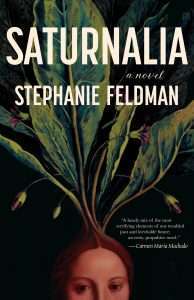 The slow-motion collapse of modern civilization is reason to party in Saturnalia, the new sci-fi horror by Stephanie Feldman, which takes place in a near-future Philadelphia amid growing climate disaster. As the world gradually succumbs to increasingly severe hurricanes, droughts, and killer mosquitos, the newly paganized City of Brotherly Love lets loose with Saturnalia, the riotous multi-day celebration of the winter solstice honoring the Roman god of abundance.
The slow-motion collapse of modern civilization is reason to party in Saturnalia, the new sci-fi horror by Stephanie Feldman, which takes place in a near-future Philadelphia amid growing climate disaster. As the world gradually succumbs to increasingly severe hurricanes, droughts, and killer mosquitos, the newly paganized City of Brotherly Love lets loose with Saturnalia, the riotous multi-day celebration of the winter solstice honoring the Roman god of abundance.
Saturnalia offers a unique take on an apocalyptic future, striking a good balance between elements of sci-fi and horror while warning of the social impact of our impending ecological disaster.
Read the full review here.
ABOUT THE BOOKThe Saturnalia carnival marks three years since Nina walked away from Philadelphia’s elite Saturn Club—with its genteel debauchery, arcane pecking order, and winking interest in alchemy and the occult. In doing so, she abandoned her closest friends and her chance to climb the social ladder. Since then, she’s eked out a living by telling fortunes with her Saturn Club tarot deck, a solemn initiation gift that Nina always considered a gag but has turned out to be more useful than she could have ever imagined.
For most, the Saturnalia carnival marks a brief winter reprieve for the beleaguered people of the historic city, which is being eroded by extreme weather, a collapsing economy, and feverish summers—whose disease carrying mosquitos are perhaps the only thing one can count on. Like Thanksgiving or Halloween, Saturnalia has become a purely American holiday despite its pagan roots; and nearly everyone, rich or poor, forgets their troubles for a moment.
For Nina, Saturnalia is simply a cruel reminder of the night that changed everything for her. But when she gets a chance call from Max, one of the Saturn Club’s best-connected members and her last remaining friend, the favor he asks will plunge her back into the Club’s wild solstice masquerade, on a mysterious errand she cannot say no to.
Tonight, Nina will put on a dress of blackest black, and attend the biggest party of the year. Before it’s over, she will discover secret societies battling for power in an increasingly precarious world and become custodian of a horrifying secret—and the target of a mysterious hunter. As Nina runs across an alternate Philadelphia balanced on a knife’s edge between celebration and catastrophe, through parades, worship houses, museums, hidden mansions, and the place she once called home, she’s forced to confront her past in order to take charge of her own—and perhaps everyone’s—future.
Read the bookThe Two Doctors Górski by Isaac Fellman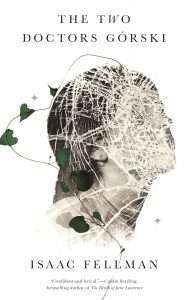 The Two Doctors Górski by Isaac Fellman is an introspective masterpiece of low fantasy and horror, exploring questions of identity, mental illness, and toxic relationships in higher education.
The Two Doctors Górski by Isaac Fellman is an introspective masterpiece of low fantasy and horror, exploring questions of identity, mental illness, and toxic relationships in higher education.
The main character, Annae Hofstader, is a 27-year-old Ph.D. student who escapes an abusive relationship with her thesis advisor at the University of California by transferring to Brandford University in England. As the only female graduate student in her program, Annae feels self- conscious and isolated.
Annae’s field of study is magic, which is viewed as both a science and an art. While her peers focus primarily on botanical applications of magic, Annae hopes to use her magical skills to cure mental illness. To aid in this endeavor, Annae has acquired the ability to enter the consciousness of other people, reading their innermost thoughts. Although she seeks to help others, she often finds herself slipping into nearby minds to escape her own troubles and insecurities.
The Two Doctors Górski is literary fantasy at its finest, a deeply contemplative and multilayered novel that explores the real psychological struggles of identity, imposter syndrome, and the trials of academic life.
Read the full review here.
ABOUT THE BOOKAnnae, a brilliant graduate student in psychiatric magic and survivor of academic abuse, can’t stop reading people’s minds. This is how she protects herself, by using her abilities to give her colleagues what they each want out of their relationship with her.
When Annae moves to the UK to rebuild her life and finds herself studying under the infamous, misanthropic magician Marec Górski, she sees inside his head a dangerous path to her redemption. Annae now faces two choices—follow in Dr. Górski’s lead, or break free of a lifetime of conditioning to follow her own path.
Read the bookSilver Nitrate by Silvia Moreno-Garcia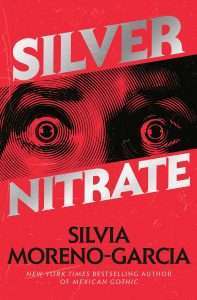 Silvia Moreno-Garcia reinvents herself once more with Silver Nitrate, an ode to classic horror films and the darker parts of twentieth century history. Silver Nitrate is set in Mexico City’s film industry in the 1990s. Centered around Montserrat, a dark-skinned sound editor in her late thirties, and her friend, Tristán, a soap opera star whose time in the limelight had long since faded, this story weaves occultist tales, fugitive Nazi occultists, and the making of horror films into an unforgettable story.
Silvia Moreno-Garcia reinvents herself once more with Silver Nitrate, an ode to classic horror films and the darker parts of twentieth century history. Silver Nitrate is set in Mexico City’s film industry in the 1990s. Centered around Montserrat, a dark-skinned sound editor in her late thirties, and her friend, Tristán, a soap opera star whose time in the limelight had long since faded, this story weaves occultist tales, fugitive Nazi occultists, and the making of horror films into an unforgettable story.
Read the full review here.
ABOUT THE BOOKFrom the New York Times bestselling author of The Daughter of Doctor Moreau and Mexican Gothic comes a fabulous meld of Mexican horror movies and Nazi occultism: a dark thriller about the curse that haunts a legendary lost film—and awakens one woman’s hidden powers.
Montserrat has always been overlooked. She’s a talented sound editor, but she’s left out of the boys’ club running the film industry in ’90s Mexico City. And she’s all but invisible to her best friend, Tristán, a charming if faded soap opera star, though she’s been in love with him since childhood.
Then Tristán discovers his new neighbor is the cult horror director Abel Urueta, and the legendary auteur claims he can change their lives—even if his tale of a Nazi occultist imbuing magic into highly volatile silver nitrate stock sounds like sheer fantasy. The magic film was never finished, which is why, Urueta swears, his career vanished overnight. He is cursed.
Now the director wants Montserrat and Tristán to help him shoot the missing scene and lift the curse . . . but Montserrat soon notices a dark presence following her, and Tristán begins seeing the ghost of his ex-girlfriend.
As they work together to unravel the mystery of the film and the obscure occultist who once roamed their city, Montserrat and Tristán may find that sorcerers and magic are not only the stuff of movies.
Read the bookNettle & Bone by T. Kingfisher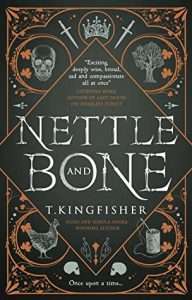 With Nettle & Bone, T. Kingfisher has created a twisted mix of morbid horror and sweet delight. Nettle & Bone is a gorgeously written dark fantasy, with a heavy dose of wit and humor. Although it is not a retelling of a typical fairy tale, there are clear fairy tale traits such as a godmother, a prince, and a nearly impossible heroic quest. Although T. Kingfisher deals with some very dark themes, she does so in a delicate and charming way.
With Nettle & Bone, T. Kingfisher has created a twisted mix of morbid horror and sweet delight. Nettle & Bone is a gorgeously written dark fantasy, with a heavy dose of wit and humor. Although it is not a retelling of a typical fairy tale, there are clear fairy tale traits such as a godmother, a prince, and a nearly impossible heroic quest. Although T. Kingfisher deals with some very dark themes, she does so in a delicate and charming way.
Read the full review here.
ABOUT THE BOOKAfter years of seeing her sisters suffer at the hands of an abusive prince, Marra—the shy, convent-raised, third-born daughter—has finally realized that no one is coming to their rescue. No one, except for Marra herself.
Seeking help from a powerful gravewitch, Marra is offered the tools to kill a prince—if she can complete three impossible tasks. But, as is the way in tales of princes, witches, and daughters, the impossible is only the beginning.
On her quest, Marra is joined by the gravewitch, a reluctant fairy godmother, a strapping former knight, and a chicken possessed by a demon. Together, the five of them intend to be the hand that closes around the throat of the prince and frees Marra’s family and their kingdom from its tyrannous ruler at last.
Read the bookThe post Top ten new horror novels for grimdark fans appeared first on Grimdark Magazine.
July 20, 2023
REVIEW: Conan the Barbarian – Free Comic Book Day by Jim Zub (W) and Roberto De La Torre
The 2023 Free Comic Book Day issue of Conan the Barbarian is set deep within the grim, hilled land of Cimmeria, Conan’s homeland. After crushing three Cimmerian villages in the process, the expansionist Aquilonian empire has established the frontier outpost of Venarium. The Cimmerian barbarian tribes’ internecine feuds have left their lands ripe for colonization, or so the arrogant Aquilonians believed. Now the barbarians—temporarily united by their hatred for the foreign interlopers—scale Venarium’s palisades. Among their number is Conan, just fifteen years of age and already more impressively built than most fully grown men. It is at Venarium where Conan first bloodies his blade. Picking through the outpost’s loot he also, unexpectedly, finds himself afflicted with an intense curiosity about the outside world.
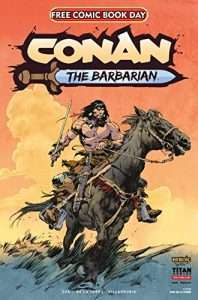 This Free Comic Book Day issue marks the first installment of Conan the Barbarian from UK publisher Titan Comics. It may sound strange to say this about a comic starring a bloody-handed barbarian, but it feels like this introduction to the new Conan the Barbarian series is about reassuring fans. While Conan is one of the most venerable fantasy characters in comics, his publication history has been rocky in recent years. The fledgling Titan Comics line appears to be an attempt to provide some welcome stability.
This Free Comic Book Day issue marks the first installment of Conan the Barbarian from UK publisher Titan Comics. It may sound strange to say this about a comic starring a bloody-handed barbarian, but it feels like this introduction to the new Conan the Barbarian series is about reassuring fans. While Conan is one of the most venerable fantasy characters in comics, his publication history has been rocky in recent years. The fledgling Titan Comics line appears to be an attempt to provide some welcome stability.
Excitement surrounded the return of the Conan the Barbarian comic book to Marvel in 2019. Conan’s 15 year stretch at Dark Horse was largely successful, but to long-time comic fans the original Marvel run beginning in 1970 is still the first incarnation of the character to come to mind. The one penned by Roy Thomas and illustrated by Barry Windsor-Smith and later John Buscema, with all of them operating at the height of their formidable powers. To many, the relaunch of the Conan the Barbarian and companion Savage Sword of Conan series felt like a homecoming.
It didn’t take long for cracks to appear, however. The flagship Conan the Barbarian series was well-received, but Marvel’s editorial decision-makers also wasted no time incorporating the venerable character into the greater Marvel universe. The Avengers: No Road Home (2019) story line saw him join forces with Wanda Maximoff, the Scarlet Witch. Conan also took on a primary role in the subsequent Savage Avengers series, alongside Wolverine, The Punisher, Venom, etc. While crossovers such as these were not unknown during the classic Marvel era, they were largely confined to the non-canon What If…? title. Many readers—not limited to purist fans of Robert E. Howard’s original literary Conan, but also including fans from the crossover-light Dark Horse Comics era—opposed this sort of crossing of the streams.
Far more damaging, however, were the production and publication days that accompanied the pandemic. After the conclusion of Jason Aaron’s “The Life and Death of Conan” arc, writing duties on the core Conan the Barbarian title passed to fantasy comic veteran Jim Zub. Just two issues into Zub’s “Into the Crucible” story line, production was halted, with supply chain issues cited as the cause. There was a seven-month gap between issues, stunting the momentum the plot had accumulated. The mainline Conan the Barbarian series lasted ten more issues, and a six-issue King Conan miniseries followed, but by mid-2022 Marvel announced they had declined to renew the Conan character license.
With the Marvel experience still fresh in public memory, Titan Comic’s Free Comic Book Day issue of Conan the Barbarian seems like an attempt to satisfy and reassure three segments of the audience: neophytes, existing Conan comic fans, and fans of the original pulp fiction character.
Newcomers to the character are given an easily digestible origin story; they’re introduced to Conan during his very first battle and learn the motivation for his wandering life of adventure. There’s no exposition info-dump or dense setting lore, we meet the hero when he’s just starting out, see him in an action-packed situation, and receive some tantalizing hints about future adventures.
Readers already familiar with earlier comic book incarnations are given an immediately familiar-looking depiction of the character: Roberto De La Torre’s lines are strongly reminiscent of John Buscema’s classic Marvel portrayal of Conan. Jim Zub has been given another chance to write the character, and even the colorist and letterer (Jose Villarrubia and Richard Starkings, respectively) are veterans of the Dark Horse Conan series. When Conan’s future love interest Belit is glimpsed in a brief foreshadowing sequence, she appears in her classic Marvel furs. When Conan leaves Venarium behind in search of adventure, he even picks up and dons a horned helmet vaguely similar to the one given him by original Marvel artist Barry Windsor-Smith. The message seems to be that this is the comics Conan you know and love, delivered by people you can trust.
Finally, while they might not be the largest audience or the most impactful on comics sales, fans of Conan creator Robert E. Howard’s original pulp stories are also given some attention. The sack of Venarium depicted in this issue is adapted from a few lines in “Beyond the Black River,” a short story that appeared in a 1935 issue of Weird Tales magazine. When the reader is given a glimpse of Conan’s future exploits, situations from Conan’s other pulp appearances (“The God in the Bowl,” “The Tower of the Elephant,” “Rogues in the House,” “The Queen of the Black Coast”) are shown. The issue even concludes with a brief essay by Howard scholar Jeffrey Shanks that highlights the character’s long literary history and explores why Conan’s stories still resonate today.
While the Free Comic Book Day issue of Conan the Barbarian is only a brief taste, this fan has been duly reassured. De La Torre’s artwork is gorgeous and dynamic, and it hearkens back to some of the most beloved depictions of the character. Jim Zub has been vocal about his enthusiasm for Conan for many years, and there’s no other active comic writer I trust more to do the barbarian justice. Conan the Barbarian Issue #1 can’t come soon enough.
The post REVIEW: Conan the Barbarian – Free Comic Book Day by Jim Zub (W) and Roberto De La Torre appeared first on Grimdark Magazine.
An Interview with David Wragg
Hi David! Thank you so much for taking the time to do this interview with me here at Grimdark Magazine. At the time of writing I’ve almost completed my readthrough of The Hunters and I’m absolutely loving it so far. Comparisons to Joe Abercrombie meets Mad Max: Fury Road feel very much warranted and I’m looking forward to sharing my full review with readers soon.
In the meantime, I’ve compiled a list of questions I’d dearly love for you to answer—both for myself and Grimdark Magazine readers—so without further ado, let’s jump right in:
[GDM] As previously mentioned, you have a new book coming out, The Hunters. Can you tell us a little bit about it in your own words?
[DW] Certainly! The Hunters is a fantasy Western, largely concerned with strained family dynamics in times of mortal peril. It takes place in the wild, untamed frontier lands of the Serican Protectorate, and features a middle-aged woman called Ree with a chequered past who’s looking for a quiet life, and her 12-year-old niece Javani, who is looking to make her life considerably louder. One day, two separate bands of killers arrive in the little mining town where they’re scratching a living, looking for a white-haired woman and a child in her care, and Javani gets her wish…
 [GDM] The Hunters is set 13 years later in the same world as your Articles of Faith. Can veteran fans expect any crossover between the two?
[GDM] The Hunters is set 13 years later in the same world as your Articles of Faith. Can veteran fans expect any crossover between the two?
[DW] Oh, they absolutely can. I won’t spoil anything (and will stress that there’s absolutely no need to read the first series to enjoy this one) but there are some major connections and some very minor ones too, and by the end of the Tales of the Plains trilogy you’re going to be seeing one of two familiar faces again. They won’t always be using the same names, mind, and will have aged a bit (and probably lost a finger or ear or two), so some deduction may be required…
[GDM] What was it like embarking on a new project outside of the Articles of Faith series?
[DW] In some ways, no different, and in others a total change. The idea for The Hunters came from a fortunate confluence of factors – wanting to write something set in the same world, feeling the need to follow up on some of the looser threads from the end of The Righteous, and liking the idea of a fantasy Western. The events of The Righteous gravitate to an arid place called Serica which encompasses enormous plains, mountains, and deserts, and following a story into those plains seemed such a natural fit I couldn’t resist.
In terms of the story, though, I wanted to do something a little different – leave some of the shades-of-grey cynicism behind, and centre the female characters of the world a little more. If Articles of Faith was about absent father figures, The Hunters has far more of an interest in lost mothers.
 [GDM] The Hunters really transported me to a sun-baked, rough and ready fantasy Wild West. Did you do any research into our real-world Wild West, and if so, are there any fun or interesting titbits you discovered that didn’t make it into the book?
[GDM] The Hunters really transported me to a sun-baked, rough and ready fantasy Wild West. Did you do any research into our real-world Wild West, and if so, are there any fun or interesting titbits you discovered that didn’t make it into the book?
[DW] Enormous quantities, and thoroughly enjoyable it was too. One point of interest though is that the setting is a Westernised version of the Persian plateau, essentially a chunk of present-day Iran (Articles of Faith was set in an analogue of 13th century Transcaucasia, and they travelled far enough across the map to reach Persia by the end of it). This gave me a tremendous amount to work with in terms of interesting period settlements and constructions – the wind catchers, caravanserais and icepits, the glorious terraced paradise gardens of the Guildhouse – but the one thing I was very sad to lose was a section where Ree and Javani sneaked into the Guildhouse via its underground water channel, which shed a little light on how the settlement operated so well, even on the dry side of the mountains. Oh well, maybe in a sequel!
[GDM] Westerns are such a towering genre of cinema—and in literature too. What are some of your favourite Westerns and did any of them directly inspire or influence the writing of The Hunters in some way?
[DW] It’s hard to trace a direct line, but I’ve certainly hoovered up a great deal of Western fiction in both book and film/TV. In terms of favourites, Lonesome Dove is hard to beat, but I’d say True Grit has it pipped. A lesser known but equally majestic work is Oakley Hall’s Warlock, although how much direct influence it had I couldn’t say – it’s just a damned fine read. The more obvious filmic influences are inevitably somewhere between Fury Road and the old Mel Gibson film Maverick, if only for its goofiness.
[GDM] Who or what did you sacrifice to the cover gods to obtain such wonderfully vibrant, quirky character art for your books?
[DW]: Unfortunately, the contract I signed with my own lifeblood prevents me answering, but I can say that I have been very lucky indeed – Gavin Reece is a superstar artist and one of the best things about doing a trilogy is getting excited about another two covers after this one.
[GDM] Speaking of characters, we meet so many great ones in The Hunters. Who were your favourites to write? Who gave you the most difficulty and why?
[DW] Aki and Anashe are almost certainly the most fun, if only because they spend the bulk of the book locked in sibling bickering while absolute chaos unfolds around them. Ree and Javani are easy for me to write though, they’re so real to me and their relationship sparks so naturally from their respective ages and viewpoints. Needless to say, it’s more arguments.
I can’t say there were really any hard characters to write – most of them were either great fun or, er, not around that long…
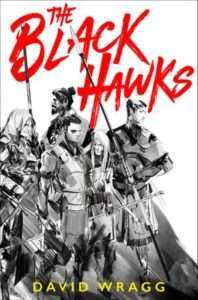 [GDM] I love how all your characters seem to have a little feature about them; something that makes them striking and memorable to the reader such as the taciturn White Spear’s black armour, Ree’s white hair and Lazant’s moustache. Is this something that helps you as a writer in keeping track of such a large ensemble cast? In what other ways do you endeavour to make your characters so distinctive?
[GDM] I love how all your characters seem to have a little feature about them; something that makes them striking and memorable to the reader such as the taciturn White Spear’s black armour, Ree’s white hair and Lazant’s moustache. Is this something that helps you as a writer in keeping track of such a large ensemble cast? In what other ways do you endeavour to make your characters so distinctive?
[DW] That’s a really good question. I think in many ways I need to make them distinctive to myself first, and fill in gaps in how they present and act as I flesh them out (either in planning or in the actual writing). One of the nice things about writing is you can, for example, decide in the very last chapter that a character has always had a jaunty earring, then run back through the book and add it in all the way through, and you can look like you meant it all along.
Not that I’d do that of course, I always plan everything totally.
[GDM] Alongside all the action, wit, hilarity, banter and cameltastrophes in The Hunters, there are also very prominent themes and messages about what truly makes a family. How important is it for you to balance humour with more serious themes like this?
[DW] It’s amusing to me that often this question gets asked the other way around – I think we understand that serious, weighty books need moments of levity, and the same is absolutely true in reverse. You can laugh your way through something, but if it doesn’t make you feel, it’s not going to leave much of an impression.
Also writing proper full-on comedy is really, really hard and I take my hat off to those who have mastered it.
[GDM] Do you have a favourite line that you wrote from the book? Please do share it with us!
[DW] I do have a favourite exchange, although I’m not sure how much sense it makes in isolation.
‘Here it comes!’
The horses’ hoof-beats were a thunderous crash as they hit the bridge, the wagon’s wheels a rattling roar in their wake. The bench rattled and shook beneath Javani, almost jolting the reins from her hands.
‘Count down to the far side!’ Ree shouted. She sounded further back inside the wagon.
‘What?’
‘How long to the other side! Count down!’
‘What?’
‘Like five, four, and so on!’
‘Oh!’ Javani blinked sweat from her eyes. The red rock of the other side was rushing towards her. ‘One!’
‘Oh for fuck’s—’
[GDM] The Hunters is the first book in the Tales of the Plains What can the reader expect next? Do you have any other exciting projects in the pipeline?
[DW] Weeeell, without giving too much away, Ree and Javani are going to continue their adventures in new and interesting places and new and interesting ways, but they’re going to find that the past has a way of keeping up. One of the attractions of writing a Western trilogy was to explore the notions of ethical behaviour in lawless situations – can we be good for the right reasons, without the machinery of state around us to protect/coerce us? What happens if there is something large and powerful that doesn’t have everyone’s best interests at heart?
I’ll be working on the trilogy for the next couple of years (book 2 is currently in edits, book 3 is currently one chapter long), and after that, it might be time for a change of scene. Watch this space!
Read The Hunters by David WraggThe post An Interview with David Wragg appeared first on Grimdark Magazine.



